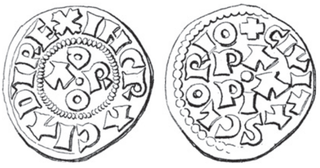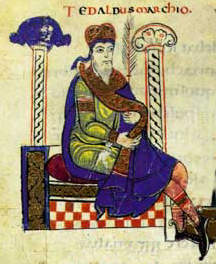
The Ottonian dynasty was a Saxon dynasty of German monarchs (919–1024), named after three of its kings and Holy Roman Emperors named Otto, especially its first Emperor Otto I. It is also known as the Saxon dynasty after the family's origin in the German stem duchy of Saxony. The family itself is also sometimes known as the Liudolfings, after its earliest known member Count Liudolf and one of its most common given names. The Ottonian rulers were successors of the Germanic king Conrad I, who was the only Germanic king to rule in East Francia after the Carolingian dynasty and before this dynasty.
Pope Benedict VI was the bishop of Rome and ruler of the Papal States from 19 January 973 to his death in 974. His brief pontificate occurred in the political context of the establishment of the Holy Roman Empire, during the transition between the reigns of Otto I and Otto II, incorporating the struggle for power of Roman aristocratic families such as the Crescentii and Tusculani.

Theophanu was empress of the Holy Roman Empire by marriage to Emperor Otto II, and regent of the Empire during the minority of their son, Emperor Otto III, from 983 until her death in 991. She was the niece of the Byzantine Emperor John I Tzimiskes. She was known to be a forceful and capable ruler. Her status in the history of the Empire in many ways was exceptional. According to Wilson, "She became the only consort to receive the title 'co-empress', and it was envisaged she would succeed as sole ruler if Otto II died without a son."

Otto II, called the Red, was Holy Roman Emperor from 973 until his death in 983. A member of the Ottonian dynasty, Otto II was the youngest and sole surviving son of Otto the Great and Adelaide of Italy.

Louis V, also known as Louis the Do-Nothing, was a king of West Francia from 979 to his early death in 987. During his reign, the nobility essentially ruled the country. Dying childless, Louis V was the last Carolingian monarch in West Francia.

Lothair, sometimes called Lothair II, III or IV, was the penultimate Carolingian king of West Francia, reigning from 10 September 954 until his death in 986.

The Archdiocese of Milan is a Latin Church ecclesiastical territory or archdiocese of the Catholic Church in Italy which covers the areas of Milan, Monza, Lecco and Varese. It has long maintained its own Latin liturgical rite usage, the Ambrosian rite, which is still used in the greater part of the diocesan territory. Among its past archbishops, the better known are Ambrose, Charles Borromeo, Pope Pius XI and Pope Paul VI.

Arduin was an Italian nobleman who was King of Italy from 1002 until 1014.

Hermann Billung was the margrave of the Billung March from 936 until his death. The first of the Saxon House of Billung, Hermann was a trusted lieutenant of Emperor Otto I.

Fulk the Venerable was archbishop of Reims from 883 until his death. He was a key protagonist in the political conflicts of the West Frankish kingdom that followed the dissolution of the Carolingian Empire in the late ninth century.

Tedald, of the House of Canossa, was the count of Brescia from 980, Modena, Ferrara, and Reggio from 981, and Mantua from 1006. He used the title of margrave because of his vast comital holdings and their frontier nature. His family's seat was Canossa and he was the son of Adalbert Azzo of Canossa who had supported Otto I against Berengar of Ivrea and Adalbert of Ivrea. His rise was largely due to his loyalty to the Ottonian Dynasty.
The March of Ivrea was a large frontier county (march) in the northwest of the medieval Italian kingdom from the late 9th to the early 11th century. Its capital was Ivrea in present-day Piedmont, and it was held by a Burgundian family of margraves called the Anscarids. The march was the primary frontier between Italy and Upper Burgundy and served as a defense against any interference from that state.

The Anscarids or the House of Ivrea were a medieval dynasty of Frankish origin which rose to prominence in Northern Italy in the tenth century, even briefly holding the Italian throne. The main branch ruled the County of Burgundy from the eleventh to fourteenth centuries and it was one of their members who first declared himself a count palatine. The cadet Castilian branch of Ivrea ruled the Kingdom of Galicia from 1111 and the Kingdoms of Castile and León from 1126 until 1369. The House of Trastámara, which ruled in Castile, Aragon, Naples, and Navarre at various points between the late 14th and early 16th centuries, was an illegitimate cadet branch of that family.
Guido da Velate was the Archbishop of Milan from 1045 until his death, though he had simoniacally abdicated in 1067. He had been chosen as successor to Aribert by the people in opposition to the choice of the noblesse and confirmed as archbishop by the Emperor Henry III.

The Italian Catholic Diocese of Ivrea is in Piedmont. For a time the diocese included the territory which had once been the diocese of Aosta, suppressed in 1803 but restored in 1817. Up until 1517 Ivrea was a suffragan of the Archdiocese of Milan; it is now a suffragan of the Archdiocese of Turin.

Henry II, also known as Saint Henry the Exuberant, Obl. S. B., was Holy Roman Emperor from 1014. He died without an heir in 1024, and was the last ruler of the Ottonian line. As Duke of Bavaria, appointed in 995, Henry became King of the Romans following the sudden death of his second cousin, Emperor Otto III in 1002, was made King of Italy in 1004, and crowned emperor by Pope Benedict VIII in 1014.
Warmund, in Latin Warmundus, was the bishop of Ivrea from about 966 until his death. Warmund is the namesake of the so-called "Warmund Sacramentary", an illustrated manuscript produced for him around the year 1000.
Gero, Count of Alsleben, conjectured to be the son of Siegfried and therefore grandson of Gero the Great. If so, his mother was Hedwig, daughter of Wichmann the Elder. Gero was the brother of Tetta, who established a monastery at Alsleben in his name. Thietmar of Merseburg, whose Chronicon is the major source of information here, refers to Gero as a Count in Northern Thuringia and Morzani. Gero was married to Adela of an unknown family. Gero and Adela had one daughter, Adela of Alsleben, who married Siegfried II, Count of Stade. No other counts of Alsleben are recorded until the 12th century.












